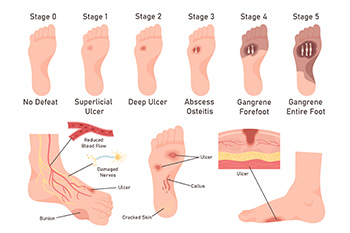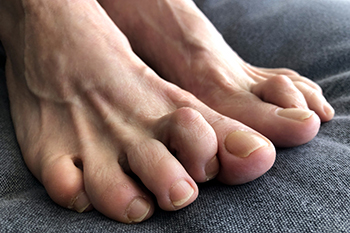Connect With Us
Blog

Diabetic foot ulcers often progress through stages that reflect increasing levels of tissue damage. In the earliest stage, the skin may appear intact, but deformities or poor circulation place the foot at risk for breakdown. A grade 1 ulcer is a shallow wound that affects only the skin’s outer layers. A grade 2 ulcer involves deeper tissues, such as tendons, ligaments, or joints. By grade 3, the ulcer may spread into the bone, creating a serious health concern. grade 4, involves dead tissue, or gangrene, at the front of the foot, and grade 5 occurs when gangrene extends throughout the entire foot, which can threaten limb preservation. A podiatrist can evaluate the severity of the diabetic foot ulcer, provide wound care, help improve circulation, and recommend surgery when necessary to reduce the risk of limb loss. If you have diabetes with developing foot ulcers, it is suggested that you schedule an appointment with a podiatrist for an exam and expert guidance in managing this serious condition.
Diabetic foot care is important in preventing foot ailments such as ulcers. If you are suffering from diabetes or have any other concerns about your feet, contact Phyllis Weinstein, DPM from California. Our doctor can provide the care you need to keep you pain-free and on your feet.
Diabetic Foot Care
Diabetes affects millions of people every year. The condition can damage blood vessels in many parts of the body, especially the feet. Because of this, taking care of your feet is essential if you have diabetes, and having a podiatrist help monitor your foot health is highly recommended.
The Importance of Caring for Your Feet
- Routinely inspect your feet for bruises or sores.
- Wear socks that fit your feet comfortably.
- Wear comfortable shoes that provide adequate support.
Patients with diabetes should have their doctor monitor their blood levels, as blood sugar levels play such a huge role in diabetic care. Monitoring these levels on a regular basis is highly advised.
It is always best to inform your healthcare professional of any concerns you may have regarding your feet, especially for diabetic patients. Early treatment and routine foot examinations are keys to maintaining proper health, especially because severe complications can arise if proper treatment is not applied.
If you have any questions, please feel free to contact our office located in Temple City, CA . We offer the newest diagnostic and treatment technologies for all your foot care needs.

A hammertoe deformity develops when a toe bends abnormally at the middle joint, creating a fixed Z-shaped position that makes it difficult to straighten. The second toe is most commonly affected, although the third or fourth toes may also be involved. A hammertoe deformity typically develops from tendon imbalances that pull the toe into the bent position. Contributing factors include unusually long toe or metatarsal bones, improper alignment of joints in the foot, inflammatory conditions like arthritis, and years of wearing shoes with a tight or narrow toe box. Because part of the affected toe sits higher than normal, constant friction against footwear can cause corns, calluses, or open sores. Pain is often noticed while walking, and some people also feel pressure in the ball of the foot. A podiatrist can evaluate the deformity, provide effective treatment, and discuss whether surgery is necessary. If you notice changes in the structure of your toe, it is suggested that you schedule an appointment with a podiatrist for an exam and appropriate treatment.
Hammertoe
Hammertoes can be a painful condition to live with. For more information, contact Phyllis Weinstein, DPM from California. Our doctor will answer any of your foot- and ankle-related questions.
Hammertoe is a foot deformity that affects the joints of the second, third, fourth, or fifth toes of your feet. It is a painful foot condition in which these toes curl and arch up, which can often lead to pain when wearing footwear.
Symptoms
- Pain in the affected toes
- Development of corns or calluses due to friction
- Inflammation
- Redness
- Contracture of the toes
Causes
Genetics – People who are genetically predisposed to hammertoe are often more susceptible
Arthritis – Because arthritis affects the joints in your toes, further deformities stemming from arthritis can occur
Trauma – Direct trauma to the toes could potentially lead to hammertoe
Ill-fitting shoes – Undue pressure on the front of the toes from ill-fitting shoes can potentially lead to the development of hammertoe
Treatment
Orthotics – Custom made inserts can be used to help relieve pressure placed on the toes and therefore relieve some of the pain associated with it
Medications – Oral medications such as anti-inflammatories or NSAIDs could be used to treat the pain and inflammation hammertoes causes. Injections of corticosteroids are also sometimes used
Surgery – In more severe cases where the hammertoes have become more rigid, foot surgery is a potential option
If you have any questions, please feel free to contact our office located in Temple City, CA . We offer the newest diagnostic and treatment technologies for all your foot care needs.

A foot blister is a small fluid-filled pocket that forms when friction irritates the skin, often caused by long hikes, wearing tight shoes, or moisture buildup. Hikers are especially prone to blisters due to repetitive movement and heat inside footwear. To prevent them, wear moisture-wicking socks, change them if they become damp, and pay attention to any hot spots that feel irritated before a blister forms. Applying protective padding or adjusting footwear early can stop blisters from developing. A podiatrist can treat existing blisters, recommend proper footwear, and provide advice to prevent recurrence. If you have developed foot blisters from hiking, it is suggested that you consult a podiatrist who can offer effective treatment and prevention tips.
Blisters may appear as a single bubble or in a cluster. They can cause a lot of pain and may be filled with pus, blood, or watery serum. If your feet are hurting, contact Phyllis Weinstein, DPM of California. Our doctor can provide the care you need to keep you pain-free and on your feet.
Foot Blisters
Foot blisters are often the result of friction. This happens due to the constant rubbing from shoes, which can lead to pain.
What Are Foot Blisters?
A foot blister is a small fluid-filled pocket that forms on the upper-most layer of the skin. Blisters are filled with clear fluid and can lead to blood drainage or pus if the area becomes infected.
Symptoms
(Blister symptoms may vary depending on what is causing them)
- Bubble of skin filled with fluid
- Redness
- Moderate to severe pain
- Itching
Prevention & Treatment
In order to prevent blisters, you should be sure to wear comfortable shoes with socks that cushion your feet and absorb sweat. Breaking a blister open may increase your chances of developing an infection. However, if your blister breaks, you should wash the area with soap and water immediately and then apply a bandage to the affected area. If your blisters cause severe pain it is important that you call your podiatrist right away.
If you have any questions, please feel free to contact our office located in Temple City, CA . We offer the newest diagnostic and treatment technologies for all your foot care needs.

